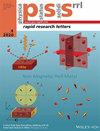High‐Performance of Self‐Powered UV‐Visible CdS (PVP)/PbI2 Heterojunction Photodetector
IF 2.5
4区 物理与天体物理
Q3 MATERIALS SCIENCE, MULTIDISCIPLINARY
引用次数: 0
Abstract
In this work, the PVP‐assisted CdS/PbI高性能自供电紫外可见 CdS(PVP)/PbI2 异质结光电探测器
本研究采用溶胶-凝胶旋涂法构建了 PVP 辅助 CdS/PbI2 异质结紫外-可见光光电探测器。X 射线衍射(XRD)、扫描电子显微镜(SEM)和能量色散光谱仪(EDS)证明了 PVP、CdS 和 PbI2 的合成和成功络合。对 CdS 和 PbI2 的紫外可见吸收光谱和紫外光电子能谱(UPS)进行了测量,证明 CdS 和 PbI2 形成了 II 型异质结。与纯 CdS 薄膜光电探测器相比,CdS(PVP)/PbI2 异质结光电探测器具有自供电特性,在紫外-可见光下表现出优异的光电导性,具有更高的开关比、检测率和更快的响应时间,分别为 1.1 × 105、9.77 × 1011 Jones 和 20 ms,在紫外-可见光自供电光电探测器领域具有巨大潜力。本文受版权保护。
本文章由计算机程序翻译,如有差异,请以英文原文为准。
求助全文
约1分钟内获得全文
求助全文
来源期刊

Physica Status Solidi-Rapid Research Letters
物理-材料科学:综合
CiteScore
5.20
自引率
3.60%
发文量
208
审稿时长
1.4 months
期刊介绍:
Physica status solidi (RRL) - Rapid Research Letters was designed to offer extremely fast publication times and is currently one of the fastest double peer-reviewed publication media in solid state and materials physics. Average times are 11 days from submission to first editorial decision, and 12 days from acceptance to online publication. It communicates important findings with a high degree of novelty and need for express publication, as well as other results of immediate interest to the solid-state physics and materials science community. Published Letters require approval by at least two independent reviewers.
The journal covers topics such as preparation, structure and simulation of advanced materials, theoretical and experimental investigations of the atomistic and electronic structure, optical, magnetic, superconducting, ferroelectric and other properties of solids, nanostructures and low-dimensional systems as well as device applications. Rapid Research Letters particularly invites papers from interdisciplinary and emerging new areas of research.
 求助内容:
求助内容: 应助结果提醒方式:
应助结果提醒方式:


